 |

| |
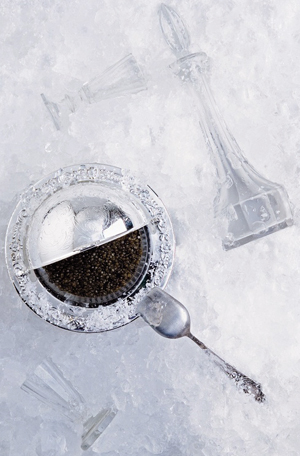
It’s not an unaffordable luxury—now, with sustainable (farmed and line-caught) caviars, it’s the luxury you deserve. Photo by Sergey Gavrilov | Fotolia. |
| WHAT IT IS: The great roes of the world: sustainable black, red and other caviars. |
| WHY IT’S DIFFERENT: No pretentiousness here: They just want you to learn about, and appreciate, the best caviars. For $65 a month (Caviar Club), you can get ongoing shipments of different varieties and experience the heavenly world of fine caviar. |
| WHY WE LOVE IT: It’s very, very fresh—no middleman is holding the goods. You deal with experts who are passionate about caviar. It's all they do. And, it couldn’t be easier—just phone by 5 p.m. Central Time and you’ll have it the next day. |
| WHERE TO BUY IT: TheLittlePearl.com |
|
|
 |

The Little Pearl:
Caviar Club
If you already love caviar, or want a chance to study it better, The Little Pearl wants to help. A purveyor of sustainable caviars from all over the world, including those farmed in the U.S., there is no intimidation, mystery or pretentiousness here: It’s a friendly place to learn about caviar (so is THE NIBBLE’s Caviar Section).
The caviar is very fresh, with a firm texture and mild taste—no saltiness or fishiness. You can taste the species character and terroir in each bite. Each jar is packed to order.
The black caviars include American Sturgeon, Bowfin, farmed Osetra from Germany, Spoonbill Paddlefish, Transmontanus Rex (our favorite!) from the U.S. and Uruguayan Baerii. There are three types of salmon caviar—Keta, King and Yukon Gold—plus Golden Whitefish and Rainbow Trout.
While The Little Pearl has some products for high rollers (for $5,000, a caviar sommelier will come to you and conduct a tasting for eight), the rest of us can enjoy a tasting sampler for $150 or join the Caviar Club and get a different shipment each month ($65/month). It’s a perfect treat or luxury gift; low calorie and high protein; sustainable; and very special. Now, you don’t have to envy how the other half lives—you can be the other half. Read the full review below.
- Read reviews of more of our favorite caviars and roes in THE NIBBLE online magazine.
- See the Table of Contents of the November issue of THE NIBBLE, plus the back issues archive and our most popular articles.
- All of the Top Pick Of The Week newsletters are permanently archived on TheNibble.com, in chronological order and by product category.
|
| |
|
|
THE NIBBLE does not sell the foods we review
or receive fees from manufacturers for recommending them.
Our recommendations are based purely on our opinion, after tasting thousands of products each year, that they represent the best in their respective categories. |
Learn More About Caviar
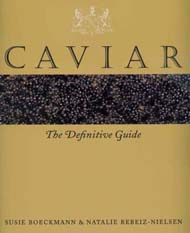 |
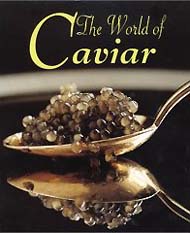 |
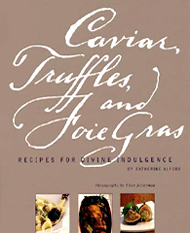 |
| Caviar: The Definitive Guide, by Susie Boeckmann. From the history of caviar to serving, matching beverages, and recipes. Click here for more information or to purchase. |
The World of Caviar, by Olivier Le Goff. An A to Z guide for all things caviar. Click here for more information or to purchase. |
Caviar, Truffles, and Foie Gras: Recipes for Divine Indulgence, by
Katherine Alford. A well-researched introduction to each of these luxury foods, along with recipes for every course. Click here for more information or to purchase. |
The Little Pearl: Caviar Club
INDEX OF REVIEW
|
MORE TO DISCOVER
|
Sturgeon, the fish that produce the choicest caviar, have roamed the seas and rivers since the age of the dinosaurs. They were enjoyed by prehistoric man and have been fished commercially for their meat and roe since 1100 B.C.E. It was a delicacy even in Greco-Roman times. King Edward II of England claimed all sturgeon as property of the King. He reigned from 1302 to 1327, when he was deposed and murdered (although not by caviar activists).
What is caviar and what is roe? The answer is different where you live, and whether or not you’re a biologist.
- The French government legally defines caviar as the eggs of sturgeon. All else is roe.
- In the U.S., the FDA defines roe as unsalted fish eggs and caviar as salted fish eggs. However, the terms are used interchangeably in retail and culinary circles—salmon roe, salmon caviar; trout roe, trout caviar; etc.
- Formerly in the U.S., caviar was used only to refer to the eggs of sturgeon, but today, any fish eggs can be caviar, as long as the name of the fish precedes the word: salmon caviar, whitefish caviar, etc.
- In Russia, black caviar comes from sturgeon, red caviar from salmon.
- In much of northern Europe, black caviar is died lumpfish or whitefish caviar. In Scandinavia, a fish paste called kaviar is sold.
- Biologically, caviar is the unfertilized eggs of fish, whereas roe defines eggs that have been fertilized and already laid.
One might expect the word “caviar” to be Russian in origin, but it isn’t. It derives from the Persian (Farsi), khag-avar, which means “roe-generator.” The Turkish word hayvar, for egg, which became caviar during trade with Italy and France and Italy in the 16th century. And the Russians refer to caviar as ikra, roe, modifying the word with the particular type of roe (beluga, sturgeon, trout, etc.).
Most people associate caviar with the Caspian Sea, the world’s largest lake, Sea, a vast body of water bordered by five countries: the Russian Federation to the northwest, Kazakhstan, to the north and northeast, Azerbaijan on the southern part of the western shore, Turkmenistan on the southern half of the eastern shore and Iran on the southern shore. The Caspian is the world’s largest lake and is home to seven different sturgeon species. The major caviar species, Beluga, Osetra and Sevruga, are all on the endangered species list, three of which are reknowned for their caviar–the Beluga, Osetra and Sevruga. and over the past ten years, other countries have begun caviar farming for both preservation and to met consumer demand. The beluga, which is enormous, cannot be farmed, but relatives of the osetra have found success, as you’ll see in the tasting notes below.
It may surprise many caviar fans to learn that in the 19th century, the U.S. was the world’s leading producer. The American caviar industry began when Henry Schacht, a German immigrant, opened a sturgeon-fishing business on the Delaware Riverm and began selling the caviar throughout the U.S. and Europe. By the end of the 19th Century, America was producing 90% of the world’s caviar. The rivers were rich with sturgeon: 3,500 tons were of caviar were harvested from the Delaware and Hudson Rivers and, once depleted, similar amounts came from the Columbia River in Oregon.
Map of Caspian Sea courtesy of Wikipedia.org.
Red Sampler basket a lovely basket of 6 caviars came with its own mother of pearl spoon tied with a satin ribbon—a perfect caviar tasting experince. Did it leave us wanting more, sure: but The Little Pearl is happy to oblige.
About Caviar
# Our caviar is best in class
# from sustainable fisheries and environmentally sensitive farms
# with pristine water and wild shrimp for feed
# that produces unparalleled tasting caviar.
# The Little Pearl is a member of Seafood Choices Alliance, Slow Food and the Edible Communities.
Caviars
Some are wild, some are farmed, all are sustainable. one person can easily polish off the six ounces of caviar as a deluxe treat or first course.
Rainbow Trout Caviar
Much of the trout caviar supply comes from Michigan, but this special rainbow trout caviar is cultured under picturesque Cold Mountain, North Carolina (of novel and film fame), fed with rainwater from Great Smoky Mountain National Park. Many experts call these the world’s finest trout, and trout caviar. We agree—it’s the tastiest, best-textured, most sophisticated trout caviar we’ve had.
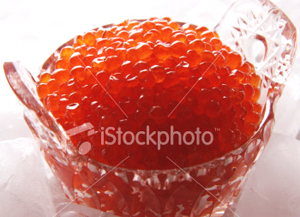
Rainbow Trout Caviar |
A unique organic feed produces a bright orange bead with a firm pop and a surprising density in the mouth. The feed enriches the caviar with omega-3, producing a complex taste and butteriness. An added nuance of minerals comes from the mountain waters that feed the pools. The eggs have a nice amount of salinity without being salty.
Remarkably, this is the only salmonid caviar that ages like sturgeon, acquiring a rich buttery flavor at 30 days.
|
The Yukon Gold Salmon Caviar
Yukon Gold Salmon caviar hails from Alaska’s mighty Yukon River. The salmon are caught in the wide, swift Yukon and Tanana Rivers that flow through Alaska’s majestic interior beneath Denali (previously known as Mt. McKinley), North America’s largest mountain.
To prepare for this 1800-mile run these fish stockpile essential omega-3 fatty acids. Taste the rich burst of salmon and feel the exceptional texture and egg definition. Each orb glows with radiant orange offers a little taste of the Yukon valley’s rich minerals and brine from Bering Sea Krill.
Yukon Gold eggs are larger and more buttery with no salinity ... if you want your caviar without saltiness, this is a good choice. Large eggs for caviar yet small for salmon, Yukon Gold bursts with intense flavor.
|
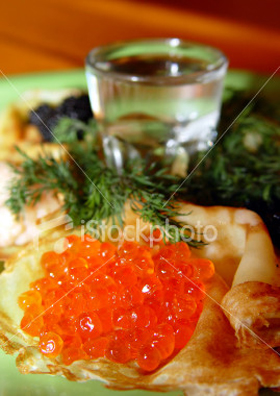
Salmon Caviar .
|
#1 Keta Salmon
#1 Keta is harvested from the Keta salmon caught in the glacial saltwater bays and fjords off Juneau, Alaska, this traditional red caviar has the largest sized egg, but a relatively mild flavor for salmon caviar—especially compared with the salty ikura many people are used to .
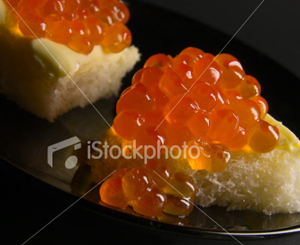
#1 Keta Salmon |
The eggs have a distinct briny salmon flavor from their diet of krill. Excellent processing preserves freshness and means that only a minimum amount of salt is needed. This has nothing to do with the the salmon caviar you buy at the store.
|
Back to Index
CAVIAR GLOSSARY
Is your naked bread unsure of what it wants for its topping? Help it understand the differences among jams, jellies, preserves, etc. |
Black Caviars
Intro
Spoonbill Paddlefish
The spoonbill paddlefish is an ancient cousin of the sturgeon. It has been wild caught in rivers of Tennessee and Ohio, and also found in Indiana, Mississippi, Missouri and Montana, where they can be seen swimming upside down, feeding on small shrimp near the surface.
While These fisheries are sustainable, but researchers have learned to breed and culture the ancient filter feeders.
This sturgeon cousin produces small grey eggs that lack the oily sheen and the pop of sturgeon caviar. But, think of the difference between salmon and arctic char: If you like one, you like the other. The flavor is lovely and a genuine caviar experience. but overall a lovely mild caviar flavor. It produces delicate caviar with a mild smoky flavor. We’ve had lots of paddlefish and much of it has a muddy flavor. This is tops.
|

Spoonfish Paddlebill: Our birthday gift.
|
Spoonbill Paddlefish is prized by traditional caviar lovers for its unique taste and texture and offers a gentle introduction for new customers. This is one of our most popular caviars because it may be enjoyed by all, alone or as a garnish. Our Swedish pancakes are mostly milk, and this balances the light acidity of Paddlefish.
American Sturgeon
Tiny black eggs, smallest size but strongest flavor. Not fishy or salty, just good.
American Sturgeon, Hackleback, or Shovelnose Sturgeon is wild caught in the rivers of the central United States.
These glistening black eggs have hints of emerald and gold. This caviar is small and firm with classic sturgeon taste. The flavor is bold and forward making Hackleback our most popular sturgeon among caviar lovers.
Hackleback is regal enough to stand as the centerpiece in American caviar tastings with the world's finest champagne or vodka. Further, the accessible price allows you to enjoy this delicacy anytime.
$26.00/ounce
Urugyan Baerii was a reveletaion, the small, gleaming black eggs yielding an intense, meaty flavor. While we liked them all, this is the one we would fall into the vat.
This Baerii (pronounced BAY-Air-ee) is probably the closest caviar to wild Caspian Osetra in terms of taste. The size is slightly smaller than Osetra or White Sturgeon but this is a superb caviar that is sustainably cultured.
Crafted by Russian scientists in Uruguay's Rio Negro, this Siberian Sturgeon (acipenser baerii) has a sweeter flavor from traditional salting methods not used in the United States. Further, the artisan attention to detail ensures every original tin is packed with exceptional care.
The luscious Rio Negro delta provides an abundance of wild plankton on which these "Osetra-class" sturgeon feed. The abundance of wild shrimp in their diet produces a nutty flavor comparable to wild Caspian Osetra (acipenser gueldenstaedtii.)
Color ranges from black with gold highlights to crimson depending on seasonal diet. That color is likely from the wild shrimp these fish consume which produces a rounded taste complexity and firm texture. These qualities combine to offer an "Old World" caviar experience.
$80/ounce
German Osetra
Cultured indoors in Germany, this is currently the only aquacultured caviar from the true acipenser gueldenstaedtii sturgeon (Osetra, or Russian Sturgeon.)
The production process creates a well manicured caviar defined by large eggs with emerald highlights. This caviar has a light, nutty flavor that finishes a slightly acidic brine that will pair well with a wide range of champagne, Riesling, and Gruner Veltliner.
You will notice well defined eggs and a gentle burst against the roof of your mouth.
Since this caviar is cultured indoors it provides a sustainable alternative to wild Caspian Osetra. Further, this species is native to Germany's major rivers and this delicacy connects you to Europe's extensive history with local caviar. Sturgeons were a banquet fish for royalty throughout the Middle Ages and cultured German Osetra is an environmentally sustainable return to that tradition.
$75.00/ounce
Transmontanus Rex
The most classic looking and tasting of Caspian caviars, pearly brown-gray eggs and
Transmontanus Rex, whose name in Latin means King of the White Sturgeon, describes our white sturgeon cultured in Idaho. In the wild, these stocks from the Columbia and Snake Rivers grow large for their 1500 mile spawning run, reaching up to 2,000 pounds. The largest Beluga on record reach 30 feet in length, but both the huso huso (Beluga) and transmontanus (white sturgeon) may weigh 1 ton. Not surprisingly, the caviar from these fish is similar in size, about 4 millimeters, though at times this strain of white sturgeon exceeds that diameter.
The flavor of Transmontanus, however, is crisp-- a product of the volcanic springs in Magic Valley, Idaho. Brilliant color contrasts range from deep black to earthy brown to translucent blue/gray. Healthy diets of natural live plankton supplement the culture regimen at these farms. Spring water flows through the system once, so there is no off-flavor from micro-algae. The most amazing aspect results from the continuous year-round harvest made possible by two water temperatures. The underground lake feeding most of the springs is quite cold, but the geothermal activity from Yellowstone’s hot springs enables the growers to gradually bring their sturgeon to maturity.
These living fossils, affectionately referred to as T-Rex, produce the largest of our sturgeon eggs. The dense texture bursts strongly. Notice the rich complexity of flavor common among large sturgeon that feed on shrimp, mollusks, and tender river plants. The taste may range from nutty to buttery depending on what that particular fish ate. However, when first harvested, you will only taste the cold spring water that is filtered and oxygenated through volcanic soil that was deposited 2.1 million years ago.
$70.00
|
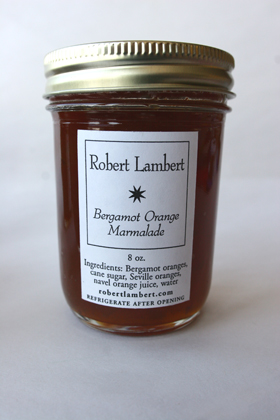
We drink Earl Grey tea every day. What a delight
to find bergamot orange, its familiar flavoring,
in a marmalade.
|
| |
If you have any British brands, taste them against this Seville marmalade. It is like comparing a normal steak to Kobe beef. So, caveat emptor: If you love orange marmalade and have a refined palate, be prepared to make a permanent switch. There’s no going back to the simplistic, sugary stuff. |
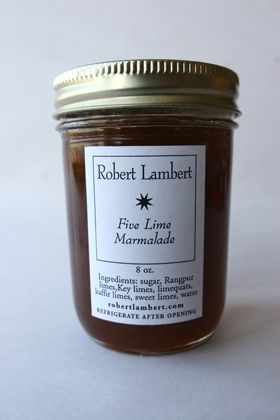
Five Lime Marmalade: Slightly tart, it complements savory foods, too. |
- Exotic Lemon Trio Marmalade
The trio tastes like a chamber orchestra of lemon. You can taste the yuzu and the Meyer lemon, two exotic species that have grown very popular with leading chefs and can be found with greater frequency in specialty produce markets. The Texas lemon is harder to come by, a hybrid with notes of citron and grapefruit.
- Five Grapefruit Marmalade blends white cocktail grapefruit with Mandalo grapefruit, the Poorman orange, a grapefruit hybrid, and two hybrids with tropical fruit notes, the Shekwasha, a Japanese citrus, and the Sacaton citrumelo, a hybrid of the hardy orange, and the pomelo. Each adds a distinctive flavor to achieve a lovely grapefruit experience, beautifully rounded with no bitterness or tartness.
- Five Lime Marmalade is perhaps the most tart marmalade, but it’s a very slight pucker. There’s an entire lime festival going on here: Kaffir limes, Key limes, Tavares limequats (a cross between the lime and the kumquat), Palestinian sweet limes (an unusual citrus in that it contains no acid) and Rangpur limes (the Rangpur is a sour mandarin). The tartness makes this an interesting condiment for savory foods: scallops, poultry and lamb (it’s a sophisticate’s mint jelly).
|
Serving Suggestions
- While our lemon dill blini and crème fraîche perfectly compliment salmon caviar,
- tops his English muffins with American Sturgeon and crème fraîche. Make your day special, you’re worth it.
- You may serve it alone, as a garnish on fish, and even in sauces.
- try Spoonbill caviar on tuna tartare or raw oysters.
- Black caviar on Brie or Camembert, like Old Chatham's Sheep's milk cheese.
For more suggestions, read the article. |
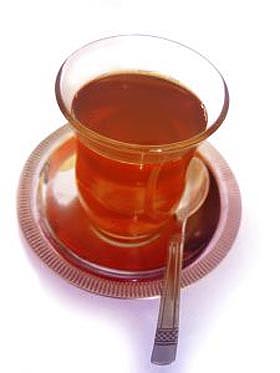
Try marmalade in your tea instead of sugar. Photo by Pakize Oztürk | Sxc.
|
- In Tea. Russians have traditionally sweetened tea with a spoonful of cherry preserves. If you like lemon in your tea, try some Exotic Lemon Trio Marmalade. Try Bergamot Marmalade in Earl Grey. Whatever you have, try it—it will work.
Marmalades are typically fruit and peel in a jelly base. These marmalades are so packed with fruit, it’s hard to find the jelly. That’s a guarantee of a jelly good time.
—Karen Hochman
FORWARD THIS NIBBLE to anyone who loves marmalade, preserves or jam.
Robert lambert marmalades
Bergamot Orange, Blood Orange, Calamondin, Exotic Lemon Trio, Five Grapefruit, Five Lime, Seville Orange
- 8-Ounce Jar
Any Flavor
$15.00
Purchase online at RobertLambert.com
Also available at fine specialty food stores. Prices and product availability are verified at publication but are subject to change. Shipping is additional.
|
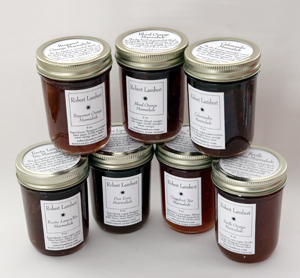
Robert Lambert’s marmalades: a symphony of citrus.
|
Read more about our favorite
spreads and other related products in
THE NIBBLE online magazine.
|
Check Out These Other “Top Picks Of The Week” From The Jam Group:
|
FOR ADDITIONAL INFORMATION, special offers,
contests, opinion surveys, THE NIBBLETM
back issues archive, product gift-finder, links to our favorite
food websites, and the ability to nominate your favorite nibbles,
visit www.TheNibble.com.
Do you have friends who would enjoy THE NIBBLE?
Click here to send them an invitation to sign up for their own copy. |
© Copyright 2004-2025 Lifestyle Direct, Inc. All rights
reserved. All information contained herein is subject to change at any time
without notice. All details must be directly confirmed with manufacturers, service
establishments and other third parties. The material in this e-zine may not
be reproduced, distributed, transmitted, cached, or otherwise used, except with
the prior written permission of Lifestyle Direct, Inc.
|